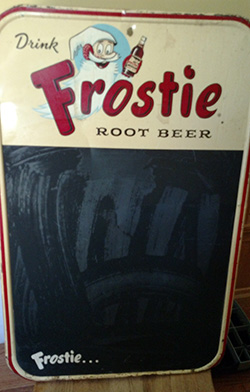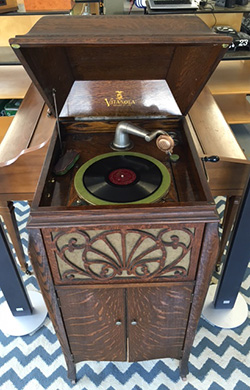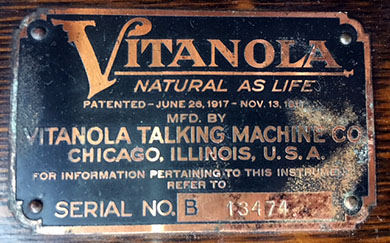 |
|
|||
 |
 |
|||
Copyright © Harry Rinker, LLC 2016 Questions
and Answers
QUESTION: I have a Frostie Root Beer chalkboard that I think dates from the late 1930s. The top is a yellow panel with “Drink” in the upper left corner, “Frostie” behind which is an image of the bearded elf holding a bottle of Frostie, and “ROOT BEER” in the lower right. “Frostie…” is on the bottom left of the chalkboard. The chalkboard measures 19 1/2 inches by 27 inches. What is its value? – K, Bernville, PA, Email Question ANSWER: Frostie, a product of the Frostie Beverage Company of Cantonsville, Maryland, first appeared in 1939. George Rackensperger, the founder of Frostie, sold the company to Monarch Beverage Company of Atlanta, Georgia, in 1979. Monarch acquired Dad’s Root Beer in 1986. At the time of acquisition, Dad’s Root Beer was distributed by Coca-Cola and was the second best-selling root beer behind A & W. Monarch devoted its financial resources to maintaining this market position, an act that reduced the funds available to promote Frostie. The Frostie brand was sold in 2000 and again in 2009 and is now owned by Intrastate Distributor Inc. of Detroit, Michigan. Root beer memorabilia is the third most popular soda pop collecting category. Coca-Cola is King of the Hill followed by Pepsi. Hires is King of the Hill in root beer memorabilia. Frostie’s collecting appeal comes from the wide variety of advertising display ad giveaway promotions associated with the soda. Advertising clocks, thermometers, and large signs are popular. A mid- to late 1960s Frostie Santa Claus doll premium was available for purchase for $1.25, no proof of purchase required. Your chalkboard dates from the late 1940s or early 1950s, albeit I did find an eBay listing for the chalkboard which the seller claims dates from 1939. In comparing the photograph that accompanied your email with the illustration in the eBay listing, I concluded it is the same chalkboard. The Frostie chalkboard closed at $122.50. There were only two bids. WorthPoint.com contains a second listing for the chalkboard for $125.00. When open bidding is allowed, a more reliable secondary market value is established. QUESTION: I have a windup, upright Vitanola record player. A metal label reads: “VITANOLA / NATURAL AS LIFE / PATENTED JUNE 26, 1917 NOV. 13, 1917 / VITANOLA TALKING MACHINE COMPANY / CHICAGO, ILLINOIS….” The cabinet has two cupboard doors at the bottom above which is an elaborate scallop-shell style filigree cutout with a cloth behind that hides the speakers. The cabinet stands about four feet tall. The phonograph appears to be in great working. The cosmetic condition is very good. It was once owned by Rusty Goodman, a member of Happy Goodman’s Gospel Group. What is its value? – KT, Email Question ANSWER: The website www.antiquephono.org contains an articles by R. J. Wakeman entitled “‘Off Brand’ Talking Machines.” In 1920, there were close to 200 phonograph manufacturers in the United States, a result of early phonograph patents filed by Columbia, Edison, and Victor having expired. The Vitanola Talking Machine Company founded in 1915 and located at 17 North Wabash Avenue in Chicago was one of them. Many of the companies were short lived. Many off brand companies had limited distribution. In some cases, department, furniture, music and piano stores had companies produce phonographs under their brands. Common elements included reproducers that could be turned to play horizontal or lateral shellac records, poorly tapered tone arms, tone arms made from pot metal, and veneered cabinets. Parts were purchased from independent suppliers. Grand Rapids furniture manufacturers made many of the cabinets. Many companies added “ola” to their name, a popular trend of the time. By 1921, the phonograph market was flooded. A mild depression occurred at the same time. Bankruptcies were commonplace. By 1925, most off brand manufacturers went out of business. Wakeman’s article contains a full page advertisement for Vitanola phonographs. The advertisement boasts: “When we first entered the field of talking machine manufacture ours was the idea that there was a tremendous field for a phonograph low in price but still of the first quality in design, material, construction and finish. / That our idea was correct is evidenced by the fact that in a few short years we have become one of the leading phonograph manufacturers in America / We have passed through many periods of discouragement and, with the coming of radically increased costs in material, have been obligated to make small adjustments in prices. But the quality of Vita-nola machines has suffered nothing….Seven models from $25.00 to $175.00.” Although the advertisement did not show your exact design, the cabinets of the models shown are very similar. [See: http://www.antiquephono.org/brand-talking-machines-r-j-wakeman/] A Vitanola upright phonograph sold for $215.00 on January 20, 2007 at Burley Auction Group. On November 14, 2014, Spence Sales sold a Vitanola for $530.00. The machine was accompanied by 31 78rpm records. The latter is a very strong price. A more realistic price for your machine is between $350.00 and $400.00
QUESTION: I recently attended the auction of a long-time friend, where I purchased a most unusual arm chair. The back and seat have a maroon base, multi-colored floral upholstery with a center medallion of a dancing couple dressed in Renaissance costumes. The cyma-curved arms end in an acanthus-leaf motive with rosettes on each side. The front support posts for the arms are turned. The motif is continued in the legs and stretcher. The front stretcher is a flat board with relief scroll and leaf carvings. The chair has hairy paw feet. I paid $110.00 for the chair. What is the age of my chair and did I pay too much? – C, Reading, PA, Email Question. ANSWER: Your chair, which dates from the 1920s or 1930s, is a Colonial Revival piece that exhibits design elements associated with a William and Mary (1695-1730 – American dates) armchair. Your chair is a copycat (stylistic copy). Neither William and Mary nor any member of aristocracy ever sat in an identical period chair. The upholstery appears period to the date of the chair’s manufacture and in surprisingly good condition for a chair that old. Auctioneers and estate sale managers love to sell an estate belonging to a local person who had a large cadre of older friends. Many who grew up in the mid-20th century have an “I want something by which to remember my friend” mentality. If the friend did not designate a gift in his/her will or the heirs did not see fit to allow the selection of an object, the only choice is to buy the “remembrance” at the estate sale or auction. One of my favorite stories involved the members of my mother’s bridge club. In the months leading up to her death, I repeatedly asked my mother what pieces she had promised to others. We made a list. The members of her bridge club were not included. Shortly after my mother’s funeral, a knock on the front door of my mother’s house signaled the arrival of the surviving club members. “How nice,” I thought. “They have come to express their condolences.” When I inquired what I could do for them, the leader of the group indicated they had come to select a memento from my mother’s house. I was informed this was an established tradition in the club. I was younger and dumber at the time. After I retrieved my mouth from the floor to which it had fallen, I agreed to their request. Each member of the bridge club chose a small item, nothing I would miss. The ladies thanked me profusely and left. To this day, I wonder what happened to their selections. Although you did not set a national record price for the chair, you may have set a regional record. The market for 1920s-1930s Colonial Revival furniture in eastern Pennsylvania is minimal. Under normal circumstances, the chair should have sold for less than $50.00. There are two possible reasons why you paid more: (1) competing against another friend who just had to have the piece or (2) a dealer, or worse yet an auction shill, deliberately ran up the price. Hopefully, it was not the latter. Forget what you paid. The chair serves as a constant reminder of your friend. This value is way beyond financial. QUESTION: I own a Camillus electrician’s knife that I acquired about 35 years ago. Does it have any resale value? – J, Bozeman, MT ANSWER: The website www.allaboutpocketknives.com contains a post entitled “Camillus electrician’s knife variations,” the information of which falls into the “more than I really want to know” category. There are four keys to dating the knife: (1) the location of the bail, (2) number of holes drilled in the sides, (3) finish, and (4) tang stamp. [For more detail, see: http://www.allaboutpocketknives.com/knife_forum/viewtopic.php?t=19139] Your knife has reuse rather than collector value. The standard asking price for a used Camillus electrician’s knife in fine or better condition is between $15.00 and $20.00, far less than a modern example costs. The exception is a Camillus World War II Army and Navy Signal Corp electrician’s knife. Asking prices for these range from $45.00 to $60.00. Harry L. Rinker welcomes questions from readers about
collectibles, those mass-produced items from the twentieth and twenty-first centuries.
Selected letters will be answered in this column.
Harry cannot provide personal answers.
Photos and other material submitted cannot be
returned.
Send your questions to: Rinker on Collectibles, 5955 Mill
Point Court SE, Kentwood, MI 49512.
You also can e-mail your questions to
harrylrinker@aol.com.
Only e-mails containing a full name and mailing address
will be considered.
You can listen
and participate in
WHATCHA GOT?, Harry’s
antiques and collectibles radio call-in show, on Sunday mornings between 8:00 AM
and 10:00 AM Eastern Time.
If you
cannot find it on a station in your area,
WHATCHA GOT?
streams live on the Internet at www.gcnlive.com.
SELL, KEEP OR TOSS?: HOW TO DOWNSIZE A HOME,
SETTLE AN ESTATE, AND APPRAISE PERSONAL PROPERTY
(House of Collectibles, an imprint of Random House Information Group, $17.99),
Harry’s latest book, is available at your favorite bookstore and via
www.harryrinker.com.
|
||||


